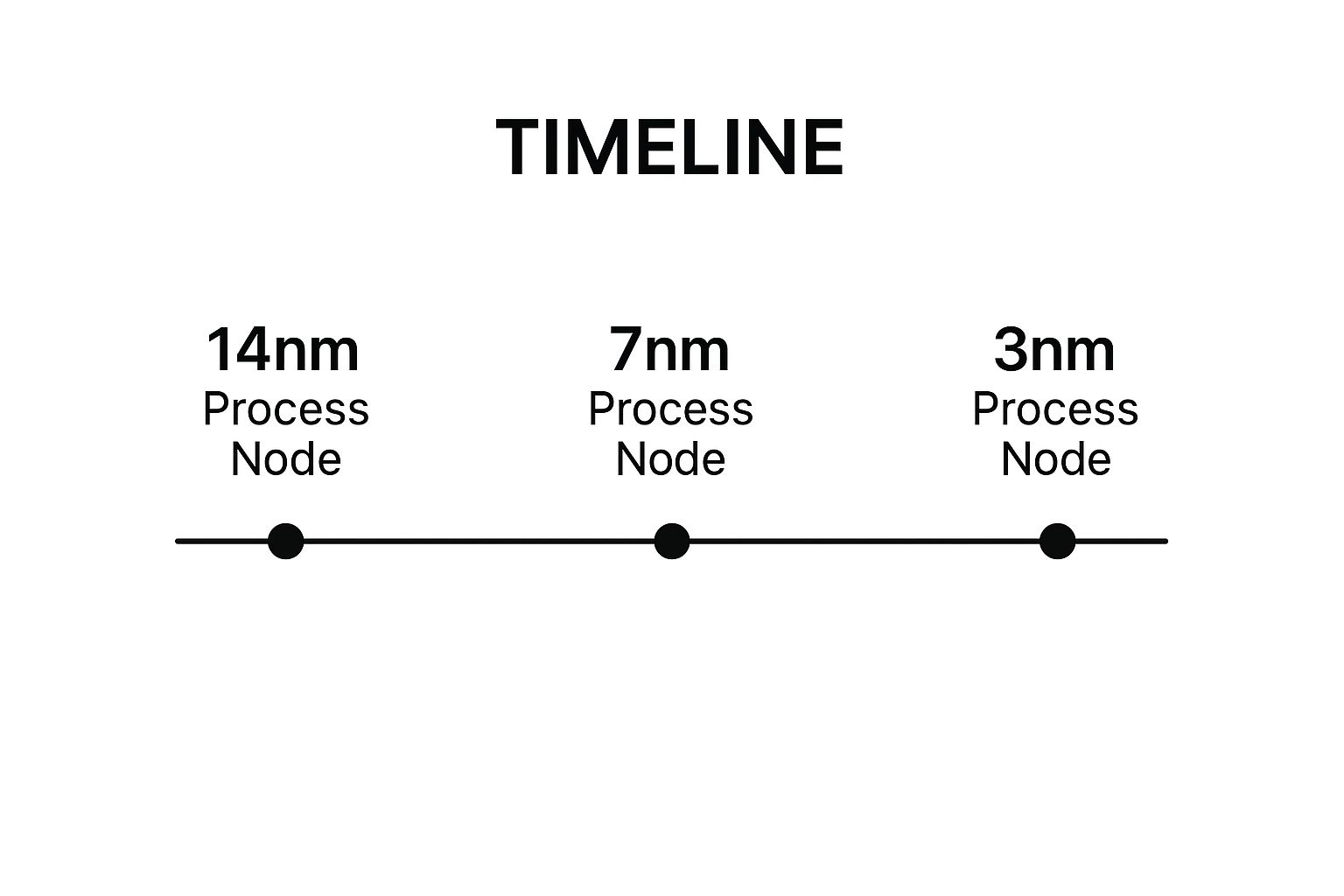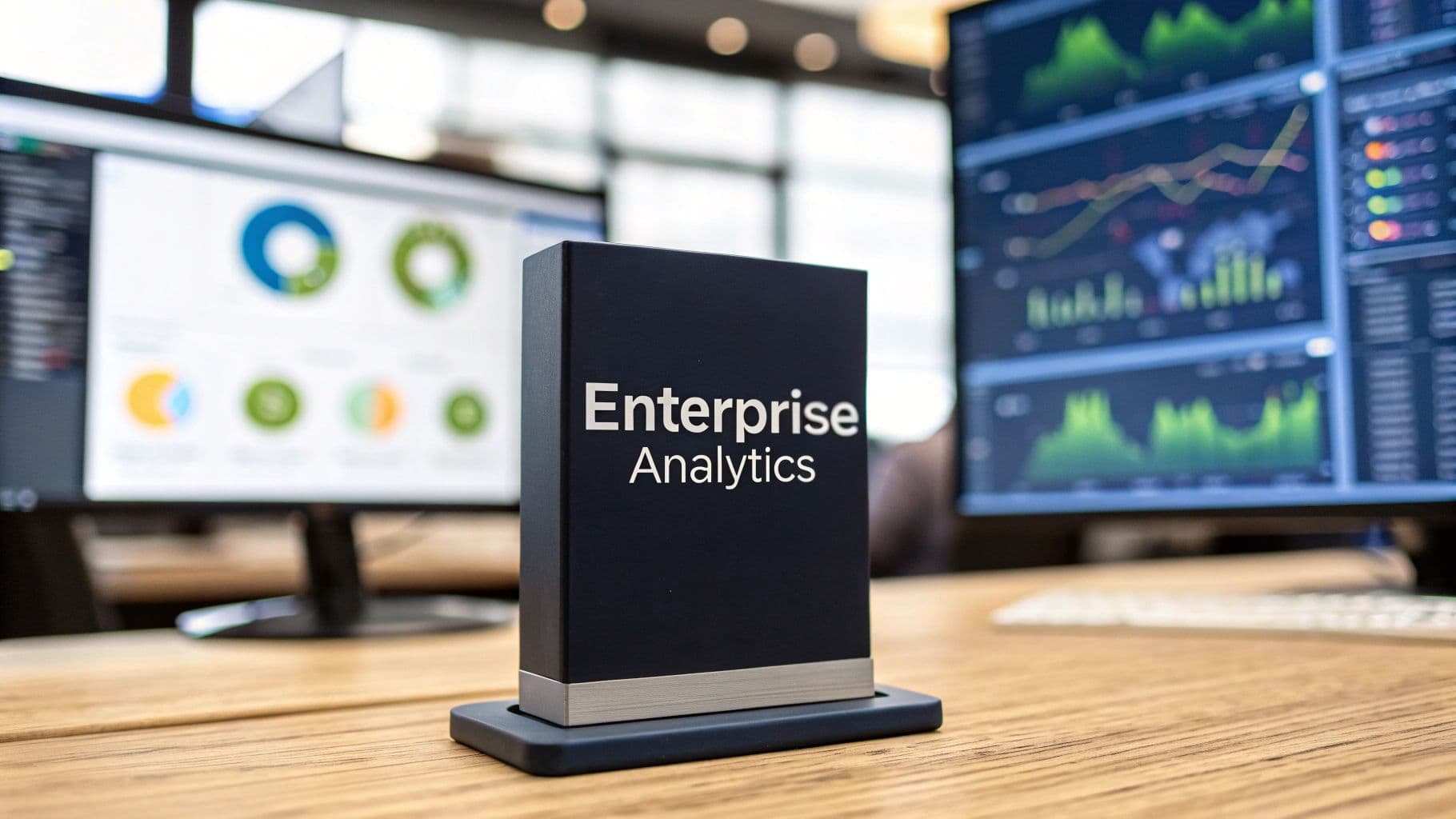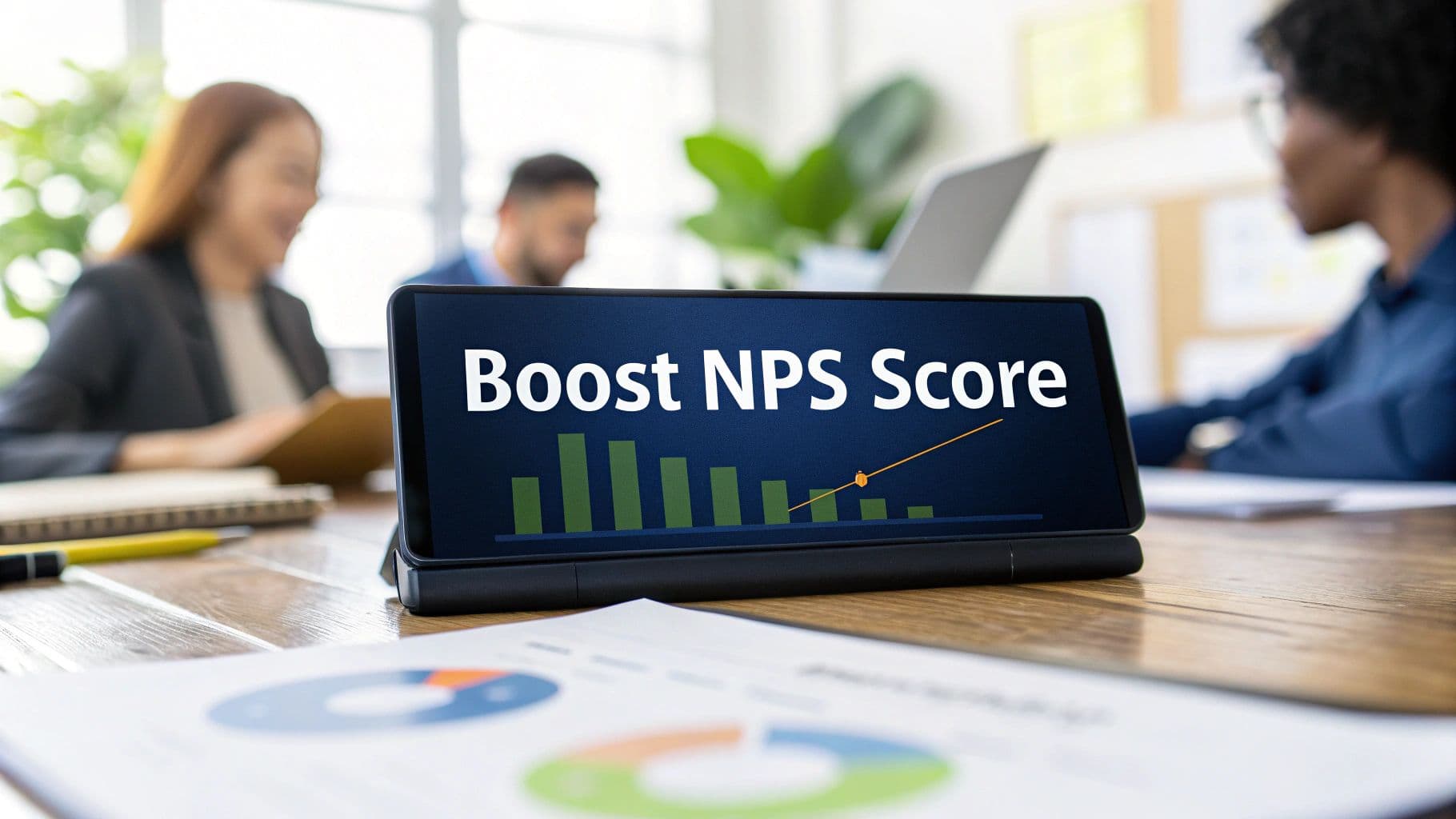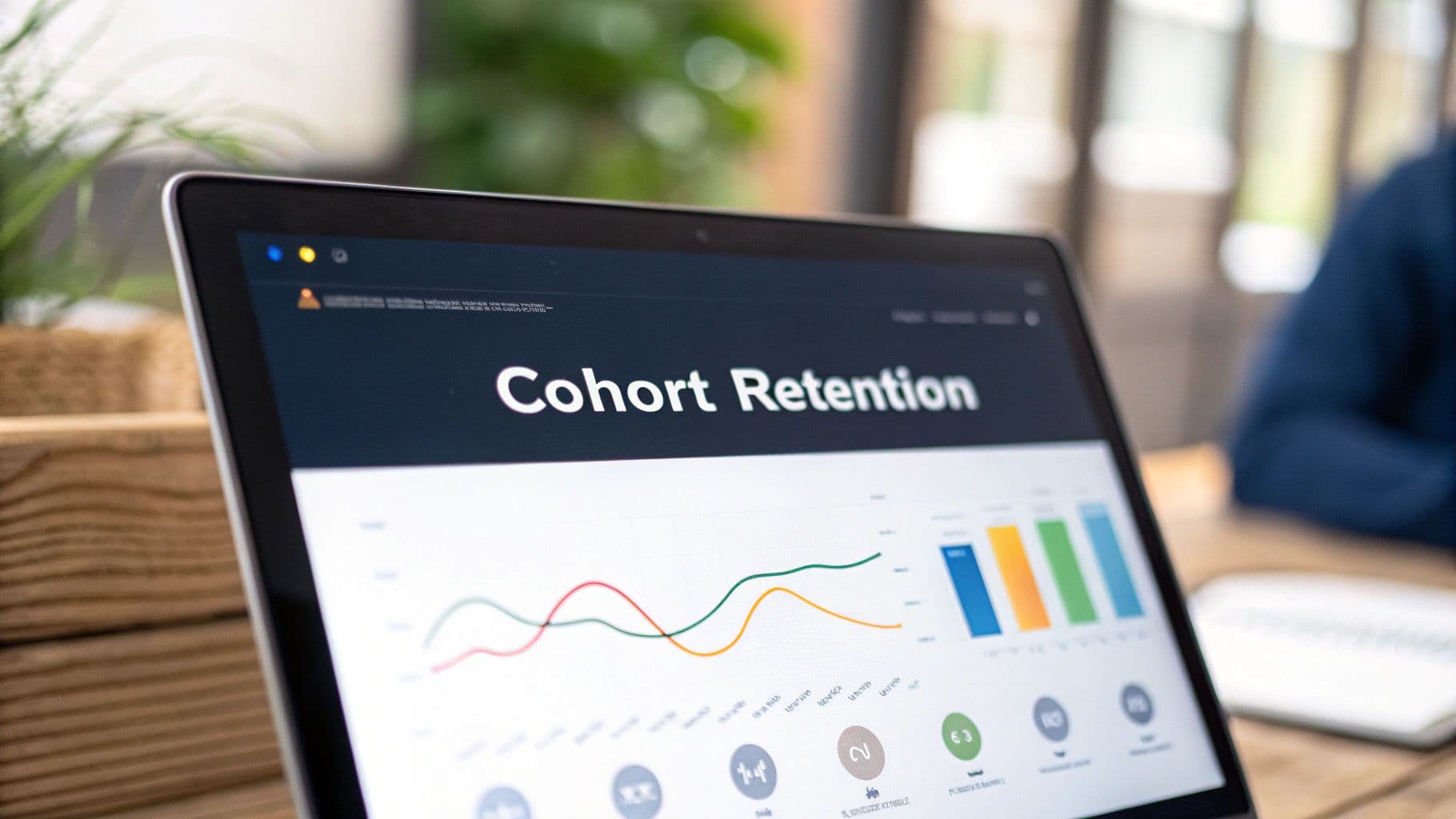8 Technology Roadmap Examples to Inspire Your 2025 Strategy
Explore 8 real-world technology roadmap examples from Tesla, Intel, and Apple. Get actionable insights & strategies for your SaaS product team.

A great technology roadmap is more than a Gantt chart or a list of features; it’s a strategic narrative that aligns teams, secures investment, and conquers markets. It visualizes the critical path from today’s capabilities to tomorrow’s innovations, connecting high-level business objectives to the concrete technical initiatives required to achieve them. Yet, many product and engineering teams struggle to create more than just a static plan that quickly becomes obsolete, failing to communicate the "why" behind the "what."
The secret to building a dynamic, influential plan lies in learning from those who have successfully navigated massive technological shifts. This article moves beyond generic templates to dissect eight powerful technology roadmap examples from industry giants like Tesla, Apple, and Microsoft. We won't just show you what they did; we'll break down the strategic thinking behind their success.
You will learn to identify:
- Replicable Strategies: How they align long-term vision with short-term execution.
- Actionable Tactics: The specific communication and planning methods they use.
- Key Takeaways: Practical insights to apply directly to your own roadmap process.
Our goal is to equip you with the strategic frameworks needed to transform your roadmap from a simple document into a powerful engine for growth and innovation.
1. Intel Semiconductor Manufacturing Roadmap
Intel's semiconductor manufacturing roadmap is a classic example of a long-term, hardware-focused technology roadmap. It outlines the company's multi-year strategy for advancing its processor technology, directly tying its goals to the principles of Moore's Law. This roadmap is a masterclass in communicating a complex, capital-intensive vision to investors, partners, and the market.
Unlike a typical SaaS product roadmap focused on features, Intel's plan centers on process node transitions. These transitions, from larger to smaller nanometer (nm) processes, represent generational leaps in chip performance, density, and power efficiency. A prime example is the recent transition to the "Intel 7" process, which powers their 12th Gen Alder Lake processors, delivering significant performance gains over previous generations.
Strategic Analysis & Actionable Takeaways
This type of roadmap is essential for industries where progress is measured in physical engineering breakthroughs. The public nature of Intel's roadmap, championed by CEO Pat Gelsinger, builds market confidence and aligns the entire supply chain, from equipment manufacturers to software developers.
Actionable Tips for Product Teams:
- Align with Customer Demand Cycles: Intel meticulously plans its process improvements to coincide with major PC and server refresh cycles, ensuring new technology meets market demand.
- Balance Ambition with Reality: While aggressive, the roadmap includes contingency plans. When facing delays with its 10nm process, Intel optimized its 14nm process to maintain competitiveness, demonstrating the need for adaptable strategies.
- Coordinate with Supply Chain Partners Early: A new process node requires years of collaboration with equipment suppliers. SaaS teams can apply this by engaging with integration partners and third-party API providers well before a feature launch.
The following timeline visualizes the immense technological progression Intel plans for its process nodes over several years.

This visualization highlights the aggressive, multi-generational planning required, showing a clear path from mature technology to the cutting edge.
2. Tesla Autonomous Vehicle Technology Roadmap
Tesla's autonomous vehicle technology roadmap represents a groundbreaking software-first approach to a hardware-intensive problem. Instead of a linear hardware development cycle, Tesla’s strategy is built on iterative software updates powered by a massive, real-world data collection loop from its customer fleet. This roadmap uniquely blends long-term hardware evolution with rapid, agile software deployments to achieve Full Self-Driving (FSD) capabilities.

The roadmap progresses from advanced driver-assistance systems (Autopilot) to full autonomy (FSD). A key example is the public FSD Beta program, which uses data from thousands of drivers to train its neural networks, demonstrating a live, evolving development process. The company’s AI Day presentations reveal the foundational technologies driving this, like the Dojo supercomputer, which is built to process the immense video data required for AI model training.
Strategic Analysis & Actionable Takeaways
This model is ideal for industries where software can continuously enhance the value of a physical product after its sale. Tesla's public communication, led by Elon Musk, creates immense market anticipation and a dedicated user base willing to participate in the beta testing process, effectively turning customers into development partners.
Actionable Tips for Product Teams:
- Build a Data Flywheel: Like Tesla, SaaS teams should design products that generate proprietary data, which can then be used to improve the core service, creating a defensible moat.
- Maintain Transparent Communication: Tesla is upfront about the limitations of its FSD Beta. Product teams launching beta programs should clearly communicate risks and capabilities to manage user expectations and build trust.
- Invest Heavily in Data Infrastructure: The ability to collect, process, and learn from data at scale is non-negotiable. This requires a roadmap that prioritizes investment in underlying infrastructure, not just user-facing features.
- Plan for Regulatory Compliance: Tesla navigates a complex and evolving regulatory landscape. Similarly, SaaS products dealing with sensitive data must plan for regional compliance (like GDPR or CCPA) from the outset.
3. Microsoft Cloud-First Technology Roadmap
Microsoft's pivot from a traditional software licensing giant to a cloud-first powerhouse is a landmark example of a transformational technology roadmap. Spearheaded by CEO Satya Nadella, this strategic shift wasn't just about launching new products; it was about rearchitecting the entire business model around cloud services, subscription revenue, and integrated platforms. It demonstrates how to steer a massive organization toward a new technological paradigm.
This roadmap’s success is visible in the evolution of its core products. Instead of selling one-time licenses for Office, Microsoft moved to the subscription-based Microsoft 365, which integrates cloud services like OneDrive and Teams. Similarly, the relentless investment in Azure has positioned it as a dominant force in cloud computing, while the recent push with Microsoft Copilot embeds AI across its entire cloud ecosystem, creating a new layer of value for subscribers.
Strategic Analysis & Actionable Takeaways
This type of roadmap is critical for established companies facing market disruption. By clearly signaling a "cloud-first, mobile-first" future, Microsoft aligned its internal teams, reassured investors of its long-term vision, and guided its vast customer base through a significant transition. The roadmap prioritized creating an interconnected platform over siloed products.
Actionable Tips for Product Teams:
- Provide Clear Migration Paths: Microsoft offered tools, incentives, and hybrid solutions to help enterprise customers transition from on-premise servers to Azure, minimizing disruption and reducing friction for adoption.
- Create Compelling Subscription Value: The value of Microsoft 365 isn't just the software; it's the continuous updates, integrated cloud storage, and collaboration tools like Teams, which justify a recurring revenue model.
- Invest in Security and Compliance: A core tenet of the Azure roadmap was building trust. Microsoft invested heavily in global compliance certifications, making it a viable choice for regulated industries and a key differentiator.
- Maintain Critical Offline Capabilities: While cloud-first, applications like Word and Excel still function robustly offline, recognizing that users require reliable access regardless of connectivity, a crucial lesson for SaaS products.
4. Apple Silicon Transition Roadmap
Apple's roadmap for transitioning its Mac lineup from Intel processors to its own custom ARM-based silicon is a landmark example of a strategic, ecosystem-driven technology roadmap. This multi-year initiative was meticulously planned to achieve vertical integration, control the user experience, and create a unified architecture across iPhone, iPad, and Mac devices. It represents a bold bet on in-house design to unlock new levels of performance and power efficiency.

Unlike a roadmap focused on a single product, this plan spanned Apple’s entire Mac portfolio. The phased rollout began with the wildly successful MacBook Air M1, which immediately established performance-per-watt leadership. The transition was enabled by crucial technologies like the Rosetta 2 translation layer, which ensured legacy Intel apps worked seamlessly on the new hardware, mitigating a major risk for users and developers. This strategy culminated in the high-end Mac Pro with M2 Ultra, completing the ambitious two-year transition.
Strategic Analysis & Actionable Takeaways
This type of roadmap is perfect for companies executing a platform-level shift that impacts hardware, software, and third-party developers. Apple’s public commitment, announced by Tim Cook at WWDC 2020, set clear expectations and mobilized the developer community to create Universal apps, ensuring a rich software ecosystem was ready from day one.
Actionable Tips for Product Teams:
- Provide Robust Emulation for Legacy Software: Just as Rosetta 2 ensured old apps worked, SaaS teams migrating to a new platform or API must provide backward compatibility or a smooth translation layer to avoid disrupting existing customers.
- Coordinate Closely with Your Developer Ecosystem: Apple gave developers a two-year heads-up and a Developer Transition Kit. When making a significant platform change, over-communicating and providing developers with the tools they need to adapt is critical for success.
- Plan for Manufacturing and Supply Chain Capacity: Shifting to custom silicon required deep collaboration with manufacturing partners like TSMC. Any major technology shift needs a corresponding roadmap for sourcing, production, and supply chain logistics to meet projected demand.
5. Google AI-First Strategy Roadmap
Google's shift to an "AI-first" company represents a paradigm-shifting strategic roadmap, moving beyond a simple feature list to a foundational technological transformation. This roadmap outlines the comprehensive integration of artificial intelligence and machine learning across its entire product portfolio, from consumer applications to enterprise cloud services. It's a prime example of a technology roadmap that redefines a company's core value proposition.
Unlike a product-specific plan, this strategy focuses on developing and deploying a core technology platform. The results are evident across Google's ecosystem: AI-powered search results that understand intent, Gmail's Smart Compose feature that predicts entire sentences, and Google Photos' ability to automatically organize and surface memories. The roadmap dictates that AI is not just an add-on but the central engine for innovation and user experience improvement.
Strategic Analysis & Actionable Takeaways
This type of roadmap is critical when a single, transformative technology is set to disrupt every aspect of a business. Championed by CEO Sundar Pichai, this strategy publicly signaled Google's long-term bet on AI, aligning internal R&D, product development, and talent acquisition toward a unified goal. This creates a powerful competitive moat built on data, infrastructure, and specialized expertise.
Actionable Tips for Product Teams:
- Prioritize Responsible AI Development: Google's strategy includes a heavy emphasis on AI safety and ethics. Product teams should create clear guidelines and invest in explainability to build user trust and mitigate risks from the outset.
- Democratize Advanced Technology: Google makes its AI tools (like TensorFlow) accessible to developers. SaaS teams can apply this by creating robust APIs and developer kits, turning their core technology into a platform that others can build on.
- Balance Innovation with User Privacy: The effectiveness of AI often depends on data. The roadmap must include a clear, transparent strategy for data governance and user privacy, ensuring that innovation doesn't come at the cost of user trust.
6. ITRS International Technology Roadmap for Semiconductors
The International Technology Roadmap for Semiconductors (ITRS) represents a monumental example of a collaborative, industry-wide technology roadmap. Rather than detailing one company's strategy, the ITRS provided a consensus forecast of the entire semiconductor industry's trajectory for over 15 years. It coordinated the efforts of competitors, suppliers, and research institutions to solve shared, pre-competitive challenges.
This roadmap was not about a single product but the foundational technologies enabling all future products. It identified critical industry-wide hurdles, such as the transition to new manufacturing techniques like EUV lithography or the development of advanced packaging. By creating a unified vision, the ITRS guided research funding, aligned equipment suppliers with manufacturer needs, and ensured the continued viability of Moore's Law on an international scale. This approach prevented duplicated effort and de-risked massive capital investments for everyone involved.
Strategic Analysis & Actionable Takeaways
The ITRS model is perfect for industries facing systemic challenges that no single company can solve alone. It demonstrates the power of creating a shared "problem-solving" roadmap that lifts the entire ecosystem. This strategic alignment accelerates innovation by ensuring that foundational research, tooling, and manufacturing capabilities evolve in lockstep.
Actionable Tips for Product Teams:
- Identify Ecosystem Dependencies: Map out the external technologies, platforms, or standards your product relies on. Collaborate with partners in that ecosystem to create a shared roadmap for critical integrations or platform upgrades.
- Contribute to Open Standards: For SaaS companies relying on open-source technologies or industry standards, participating in their roadmapping process can provide a competitive advantage and ensure the standard evolves to meet your future needs.
- Balance Consensus with Speed: While consensus is powerful, it can be slow. Use this collaborative approach for long-term, foundational challenges while maintaining agile, internal roadmaps for proprietary features and immediate market needs.
7. NASA Space Exploration Technology Roadmap
NASA's technology roadmap is an exemplar of mission-driven planning on an astronomical scale. It outlines the specific technological capabilities required to achieve the agency's long-term human and robotic exploration goals. This roadmap is a masterclass in long-range strategic foresight, breaking down immense challenges into manageable, parallel development streams.
Unlike a product roadmap focused on a single market, NASA’s plan is a portfolio of roadmaps covering 15 distinct Technology Areas, from propulsion and life support to advanced materials and robotics. For instance, the Artemis program’s goal to establish a sustainable presence on the Moon relies on successful execution across multiple technology tracks, including in-situ resource utilization to create oxygen and water from lunar regolith. This comprehensive approach ensures that foundational technologies mature in time to support flagship missions.
Strategic Analysis & Actionable Takeaways
This type of roadmap is critical for organizations pursuing audacious, multi-decade goals that depend on technology that does not yet exist. By publishing its technology needs, NASA stimulates innovation across academia, private industry, and international partners, creating a collaborative ecosystem. The roadmap, championed by leaders like Bill Nelson, aligns national resources toward common strategic objectives.
Actionable Tips for Product Teams:
- Maintain Flexibility for Mission Changes: NASA’s roadmap is a living document, adapting to new scientific discoveries and budget realities. SaaS teams should build similar flexibility into their roadmaps to pivot based on market feedback without derailing long-term vision.
- Leverage Commercial Capabilities: Through programs like the Commercial Crew Program, NASA partners with companies like SpaceX. This teaches product teams to focus on their core competencies while integrating with best-in-class third-party solutions to accelerate progress.
- Focus on Critical Path Technologies First: The roadmap clearly identifies technologies that are essential for future missions, such as the Space Launch System (SLS). This focus on "must-have" enablers ensures that foundational work is completed before dependent projects begin.
8. Automotive Industry Electrification Roadmap
The automotive industry's electrification roadmap is a powerful example of an ecosystem-wide technology transition. It coordinates immense changes across multiple sectors, moving from internal combustion engines (ICE) to fully electric vehicles (EVs). This type of roadmap goes far beyond a single company's product plan, addressing everything from battery R&D and charging infrastructure to manufacturing overhauls and new software platforms.
Unlike a focused product roadmap, this industry-level strategy involves a complex interplay of public and private commitments. General Motors' goal to be all-electric by 2035 and the European Union’s 2035 ICE ban create market-defining timelines. These targets drive specific technological pursuits, such as Volkswagen’s development of its modular MEB platform for its ID series, which standardizes components across different EV models to achieve scale and reduce costs.
Strategic Analysis & Actionable Takeaways
This roadmap is essential for managing a disruptive, long-term technological shift that requires parallel innovation across an entire value chain. Its success hinges on coordinating automakers, energy providers, governments, and component suppliers. The public and ambitious nature of these roadmaps forces alignment and accelerates investment in critical areas like battery recycling and grid modernization.
Actionable Tips for Product Teams:
- Plan for Ecosystem Dependencies: Automakers must coordinate with utility companies to ensure the electrical grid can handle increased demand. SaaS teams should identify and engage with critical integration partners or platform dependencies early in their planning process.
- Invest in the Full Product Lifecycle: Leading EV roadmaps include plans for battery recycling and end-of-life management. This full-lifecycle thinking builds sustainability and can open new revenue streams, a valuable lesson for software products.
- Develop Customer Education and Incentives: The transition to EVs requires educating consumers and offering incentives. Similarly, when introducing disruptive features, product teams must create clear onboarding, documentation, and value propositions to drive adoption.
Technology Roadmap Comparison: 8 Key Examples
| Roadmap | 🔄 Implementation Complexity | ⚡ Resource Requirements | 📊 Expected Outcomes | 💡 Ideal Use Cases | ⭐ Key Advantages |
|---|---|---|---|---|---|
| Intel Semiconductor Manufacturing Roadmap | High: advanced nanometer process development | Very high: capital-intensive fabs and R&D | Improved processor performance and efficiency | Semiconductor manufacturing and innovation | Drives industry standards; long-term planning |
| Tesla Autonomous Vehicle Technology Roadmap | Very high: hardware-software integration | High: AI compute, data infrastructure, fleet | Incremental progress to full vehicle autonomy | Autonomous driving & mobility services | Continuous OTA updates; large real-world data |
| Microsoft Cloud-First Technology Roadmap | Moderate: cloud platform and service transition | High: cloud infrastructure and security | Scalable cloud services; SaaS revenue model | Enterprise software and cloud services | Recurring revenue; global accessibility |
| Apple Silicon Transition Roadmap | High: custom ARM chip design and ecosystem shift | High: R&D and manufacturing capacity | Superior performance per watt; unified platform | Vertical integration in personal computing | Hardware-software synergy; cost control |
| Google AI-First Strategy Roadmap | High: AI research integration cross-products | Very high: compute, talent, regulatory efforts | AI-powered product innovation and ecosystem | AI-driven services, cloud, and consumer apps | Massive data leverage; strong AI platform |
| ITRS International Technology Roadmap | Very high: multi-stakeholder global consensus | High: coordinated research and industry funding | Industry-wide semiconductor tech alignment | Coordinated semiconductor industry development | Avoids research duplication; consensus-driven |
| NASA Space Exploration Technology Roadmap | Very high: interdisciplinary, long-term projects | Very high: funding, testing, and partnerships | Advanced space technologies for exploration | Human/robotic space missions and technology dev | Systematic, mission-driven innovation |
| Automotive Industry Electrification Roadmap | High: complex supply chain and infrastructure | Very high: batteries, charging, grid upgrades | Transition to electric vehicle ecosystem | Auto industry shift to electric propulsion | Environmental benefits; new business models |
Building Your Roadmap: From Inspired Examples to Actionable Strategy
We've journeyed through a diverse landscape of ambitious plans, from Intel's semiconductor dominance and Tesla's autonomous future to NASA's cosmic exploration. While a SaaS platform's goals may seem worlds apart from these examples, the underlying principles of a powerful technology roadmap are universal and directly applicable. Each of these groundbreaking technology roadmap examples illuminates a path paved with strategic foresight, disciplined execution, and a clear, unwavering vision.
The core lesson is not to replicate these roadmaps feature for feature, but to distill their strategic essence. The most effective roadmaps are not merely project plans or feature lists; they are compelling narratives that align the entire organization, from engineering to sales, around a shared destination. They transform abstract goals into a tangible, phased strategy.
Synthesizing the Core Principles
Across all the examples analyzed, from Apple's silicon transition to Google's AI-first pivot, several key themes emerge as non-negotiable for success:
- Vision-Led, Not Feature-Driven: Every impactful roadmap begins with a clear "why." For Microsoft, it was a "Cloud-First" world; for Tesla, it was accelerating the advent of sustainable transport. Your roadmap must be anchored to a core customer problem or a transformative market opportunity.
- Thematic Grouping for Clarity: Instead of a long list of individual features, successful roadmaps group initiatives into strategic themes. This approach communicates the bigger picture, helping stakeholders understand how individual projects contribute to broader goals like "Enhancing AI Capabilities" or "Improving Scalability."
- Outcome-Oriented Metrics: The goal isn't just to ship a feature; it's to achieve an outcome. A great roadmap connects technology initiatives to business metrics like reducing customer churn, increasing user engagement, or unlocking new revenue streams. This shifts the conversation from "what we are building" to "what value we are delivering."
Your Actionable Next Steps
Translating inspiration into action is the crucial final step. Don't let the scale of the technology roadmap examples we've explored intimidate you. The same strategic thinking can be applied to your product, regardless of its size or industry.
Start by asking the hard questions:
- Define Your North Star: What is the single most important long-term value proposition you offer? All technology initiatives should serve this guiding principle.
- Identify Your Strategic Pillars: What are the 3-5 core technology or product areas you must invest in to win? These become the foundational themes of your roadmap.
- Connect to Customer Value (and Revenue): For every proposed initiative, articulate which customer problem it solves. Crucially, quantify this value. Does it address a key reason for churn? Does it unlock a feature premium customers are willing to pay for?
This is where the process becomes data-driven. A modern technology roadmap cannot be built on intuition alone. It requires a robust feedback loop that channels the voice of the customer directly into the planning process. By systematically analyzing support tickets, sales call transcripts, and success team interactions, you can move from guessing what customers want to knowing what they need and how it impacts your bottom line. This data-driven approach transforms your roadmap from a static document into a dynamic, responsive strategic tool that ensures you're always building what matters most.
Ready to move beyond guesswork and build a technology roadmap grounded in real customer data? SigOS ingests and analyzes all your customer feedback, connecting product requests directly to revenue impact. See how to prioritize initiatives that reduce churn and drive expansion by visiting SigOS to transform your feedback into a powerful strategic asset.


